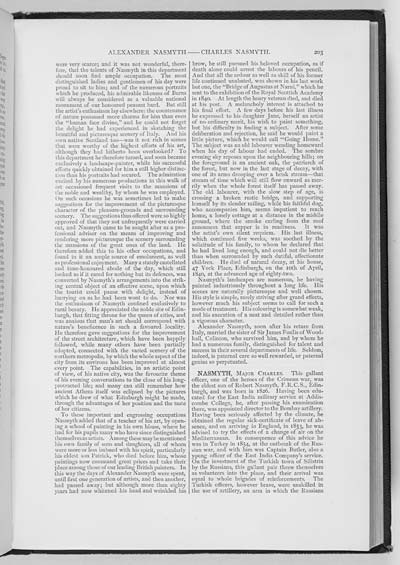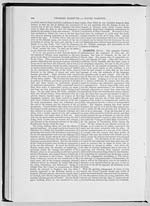203
were very scarce; and it was not wonderful, there-
fore, that the talents of Nasmyth in this department
should soon find ample occupation. The most
distinguished ladies and gentlemen of his day were
proud to sit to him; and of the numerous portraits
which he produced, his admirable likeness of Burns
will always be considered as a valuable national
monument of our honoured peasant bard. But still
the artist's enthusiasm lay elsewhere: the countenance
of nature possessed more charms for him than even
the "human face divine," and he could not forget
the delight he had experienced in sketching the
beautiful and picturesque scenery of Italy. And his
own native Scotland too�was it not rich in scenes
that were worthy of the highest efforts of his art,
although they had hitherto been overlooked? To
this department he therefore turned, and soon became
exclusively a landscape-painter, while his successful
efforts quickly obtained for him a still higher distinc-
tion than his portraits had secured. The admiration
excited by his numerous productions in this walk of
art occasioned frequent visits to the mansions of
the noble and wealthy, by whom he was employed.
On such occasions he was sometimes led to make
suggestions for the improvement of the picturesque
character of the pleasure-grounds and surrounding
scenery. The suggestions thus offered were so highly
approved of that they not unfrequently were carried
out, and Nasmyth came to be sought after as a pro-
fessional adviser on the means of improving and
rendering more picturesque the scenery surrounding
the mansions of the great ones of the land. He
therefore added this to his other occupations, and
found in it an ample source of emolument, as well
as professional enjoyment. Many a stately castellated
and time-honoured abode of the day, which still
looked as if it cared for nothing but its defences, was
converted by Nasmyth's arrangements into the strik-
ing central object of an effective scene, upon which
the tourist could pause with delight, instead of
hurrying on as he had been wont to do. Nor was
the enthusiasm of Nasmyth confined exclusively to
rural beauty. He appreciated the noble site of Edin-
burgh, that fitting throne for the queen of cities, and
was anxious that man's art should correspond with
nature's beneficence in such a favoured locality.
He therefore gave suggestions for the improvement
of the street architecture, which have been happily
followed, while many others have been partially
adopted, connected with the varied scenery of the
northern metropolis, by which the whole aspect of the
city from its environs has been improved at almost
every point. The capabilities, in an artistic point
of view, of his native city, was the favourite theme
of his evening conversations to the close of his long-
protracted life; and many can still remember how
ancient Athens itself was eclipsed by the pictures
which he drew of what Edinburgh might be made,
through the advantages of her position and the taste
of her citizens.
To these important and engrossing occupations
Nasmyth added that of a teacher of his art, by open-
ing a school of painting in his own house, where he
had for his pupils many who have since distinguished
themselves as artists. Among these may be mentioned
his own family of sons and daughters, all of whom
were more or less imbued with his spirit, particularly
his eldest son Patrick, who died before him, whose
paintings now command great prices and take their
place among those of our leading British painters. In
this way the days of Alexander Nasmyth were spent,
until first one generation of artists, and then another,
had passed away; but although more than eighty
years had now whitened his head and wrinkled his
brow, he still pursued his beloved occupation, as if
death alone could arrest the labours of his pencil.
And that all the ardour as well as skill of his former
life continued unabated, was shown in his last work
but one, the "Bridge of Augustus at Narni," which he
sent to the exhibition of the Royal Scottish Academy
in 1840. At length the hoary veteran died, and died
at his post. A melancholy interest is attached to
his final effort. A few days before his last illness
he expressed to his daughter Jane, herself an artist
of no ordinary merit, his wish to paint something,
but his difficulty in finding a subject. After some
deliberation and rejection, he said he would paint a
little picture, which he would call "Going Home."
The subject was an old labourer wending homeward
when his day of labour had ended. The sombre
evening sky reposes upon the neighbouring hills; on
the foreground is an ancient oak, the patriarch of
the forest, but now in the last stage of decay, with
one of its arms drooping over a brisk stream�that
stream of time which will still flow onward as mer-
rily when the whole forest itself has passed away.
The old labourer, with the slow step of age, is
crossing a broken rustic bridge, and supporting
himself by its slender railing, while his faithful dog,
who accompanies him, seems impatient to reach
home, a lonely cottage at a distance in the middle
ground, where the smoke curling from the roof
announces that supper is in readiness. It was
the artist's own silent requiem. His last illness,
which continued five weeks, was soothed by the
solicitude of his family, to whom he declared that
he had lived long enough, and could not die better
than when surrounded by such dutiful, affectionate
children. He died of natural decay, at his house,
47 York Place, Edinburgh, on the l0th of April,
1840, at the advanced age of eighty-two.
Nasmyth's landscapes are numerous, he having
painted industriously throughout a long life. His
scenes are naturally picturesque and well chosen.
His style is simple, rarely striving after grand effects,
however much his subject seems to call for such a
mode of treatment. His colouring is somewhat weak,
and his execution of a neat and detailed rather than
a vigorous character.
Alexander Nasmyth, soon after his return from
Italy, married the sister of Sir James Foulis of Wood-
hall, Colinton, who survived him, and by whom he
had a numerous family, distinguished for talent and
success in their several departments of life. Seldom,
indeed, is paternal care so well rewarded, or paternal
genius so perpetuated.
NASMYTH, MAJOR CHARLES. This gallant
officer, one of the heroes of the Crimean Avar, was
the eldest son of Robert Nasmyth, F.R.C.S., Edin-
burgh, and was born in 1826. Having been edu-
cated for the East India military service at Addis-
combe College, he, after passing his examination
there, was appointed director to the Bombay artillery.
Having been seriously affected by the climate, he
obtained the regular sick-certificate of leave of ab-
sence, and on arriving in England, in 1853, he was
advised to try the effects of a change of air on the
Mediterranean. In consequence of this advice he
was in Turkey in 1854, at the outbreak of the Rus-
sian war, and with him was Captain Butler, also a
y9ung officer of the East India Company's service.
On the investment of the Turkish town of Silistria
by the Russians, this gallant pair threw themselves
as volunteers into the place, and their arrival was
equal to whole brigades of reinforcements. The
Turkish officers, however brave, were unskilled in
the use of artillery, an arm in which the Russians

![]() Universal Viewer |
Universal Viewer | ![]() Mirador |
Large image | Transcription
Mirador |
Large image | Transcription
![]()

